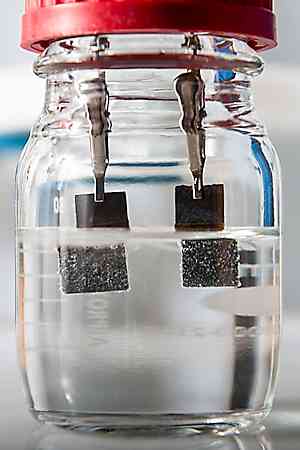
There are two big stories this week in regard to new and promising research into cheap hydrogen production and I want to talk about both of them.
In Israel, a startup company called H2Energy Now has developed a method using radio waves to zap water and extract the hydrogen gas.
According to the Times of Israel, “H2energy Now’s system uses fresh or saltwater, which is filtered into droplets. Each droplet is ‘zapped’ with radio waves, with a frequency that can ‘shake up’ the hydrogen-water bond sufficiently to separate the two gases. If saltwater is used, the salt just drops out of the water, which evaporates into the two gases (one issue Davidson is still working on is what to do with the huge amounts of salt that would be generated if the system were to be widely adopted).”
And, in other news, researchers at Stanford University have discovered a method to produce a cheap, single catalyst water splitter (pictured at top) to be used on both electrodes when electrolyzing water (a hat tip to lithium-ion battery manufacturers for helping with this method).
According to Stanford graduate student Haotian Wang, “Our water splitter is unique because we only use one catalyst, nickel-iron oxide, for both electrodes. This bi-functional catalyst can split water continuously for more than a week with a steady input of just 1.5 volts of electricity. That’s an unprecedented water-splitting efficiency of 82 percent at room temperature.”
To recap, both methods of cheap hydrogen production are exciting in their own ways. If just one of these methods were to advance into large-scale hydrogen production, it would revolutionize the production of hydrogen from water. And, if both are to succeed, well, get ready for a sweeping paradigm change.
Comments are closed here.